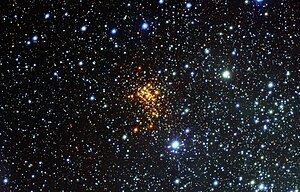Westerlund 1

Westerlund 1 (Wd1, also called Ara Cluster[1]) is a compact young super star cluster. It is in the Milky Way galaxy, about 3.5–5 kiloparsecs (12000–16000 light years) away from Earth.
It is the most massive compact young star cluster known in the entire Local Group of galaxies. It was discovered by Bengt Westerlund in 1961.[2] It remained largely unstudied for many years due to high interstellar extinction (absorption) in its direction. In the future, it will probably evolve into a globular cluster.[3]
The cluster contains a large number of rare, evolved, high-mass stars, including: six yellow hypergiants, four red supergiants, 24 Wolf-Rayet stars, a luminous blue variable, many OB supergiants, and an unusual supergiant sgB[e] star which may be the remnant of a recent stellar merger.[4] In addition, X-ray observations have revealed the presence of a strange X-ray pulsar, a slow rotating neutron star that must have formed from a high-mass progenitor star.[5][6] Westerlund 1 is believed to have formed in a single burst of star formation, so the stars have similar ages and compositions.
Apart from hosting some of the most massive and least-understood stars in the galaxy, Westerlund 1 is useful as an example of a relatively nearby, so easier to observe, super star cluster to help astronomers find out what happens in extragalactic super star clusters.
Distance and position[change | change source]
Wd1 is too far away for direct measurement of the distance by parallax measurements, so the distance must be got from the expected absolute magnitude of the stars and estimates of the extinction towards the cluster. This has been done, giving estimates of 5 kpc and 3.6 kpc by different methods. These estimates all place Wd1 near the outer edge of the Milky Way's galactic bar.
References[change | change source]
- ↑ Simbad
- ↑ Westerlund, B. (1961). "A heavily reddened cluster in Ara". Astronomical Journal. 70: 57. Bibcode:1961AJ.....66T..57W. doi:10.1086/108585. S2CID 119636689.
- ↑ Gallagher & Grebel (2002). "Extragalactic star clusters: speculations on the future". Extragalactic Star Clusters, IAU Symposium. 207: 207. arXiv:astro-ph/0109052. Bibcode:2002IAUS..207..745G.
- ↑ Clark, J. S.; et al. (2005). "On the massive stellar population of the super star cluster Westerlund 1". Astronomy & Astrophysics. 434 (3): 949–969. arXiv:astro-ph/0504342. Bibcode:2005A&A...434..949C. doi:10.1051/0004-6361:20042413. S2CID 119042919.
- ↑ "Westerlund 1: Neutron star discovered where a black hole was expected". Harvard-Smithsonian Center for Astrophysics. November 2, 2005.
- ↑ Muno, Michael P. et al 2006 (2006). "A neutron star with a massive progenitor in Westerlund 1". Astrophysical Journal Letters. 636 (1): L41–L44. arXiv:astro-ph/0509408. Bibcode:2006ApJ...636L..41M. doi:10.1086/499776. S2CID 10349450.
{{cite journal}}: CS1 maint: numeric names: authors list (link)
